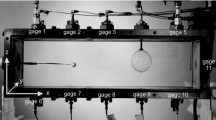Abstract
This paper presents the results of two large-scale tests performed to clarify the conditions for the detonation of propane–air compositions in model surface clouds in the absence and in the presence of confining rigid walls. Model clouds with dimensions of 15 × 6 × 4.2 and 15 × 6 × 2 m were confined by plastic tents. A mixture of the starting reagents in the cloud was ignited by hot detonation products propagating along a perforated ø0.82 × 23 m tube passing through the space of the tent. Hot detonation products were injected from the tube through holes of 20 and 40 mm diameters. Detonation of the propane-air mixture in the tube was initiated by explosion of an explosive charge placed at the tube end. Detonation occurred in the propane–air cloud bounded on one side by a rigid vertical wall, and no detonation was observed in the cloud with similar injection of hot products without a rigid wall. It is concluded that the divergence or convergence of the flows of hot detonation products plays a key role in the process, being responsible for the presence or absence of detonation, respectively, in the mixing region.
Similar content being viewed by others
References
V. C. Marshall, Major Chemical Hazards (John Wiley and Sons, New York, 1987).
S. M. Kogarko, “Pressure at the End of the Tube in Unsteady Deflagration,” Zh. Tekh. Fiz. 28 (9), 2042 (1958).
A. S. Sokolik and K. I. Shchelkin, “Flame Propagation in Mixtures of Methane and Oxygen in Closed Tubes,” Zh. Fiz. Khim. 4 (1) (1933).
A. S. Sokolik and K. I. Shchelkin, “Detonation Ability of Oxygen Mixtures of Fatty and Aromatic Hydrocarbons,” Zh. Fiz. Khim. 4 (2) (1933).
P. A. Urtiev, A. K. Oppenheim, and A. J. Laderman, “Experimental Observation of Transition to Detonation in an Explosive Gas,” Proc. Roy. Soc. London A 295, 13–28 (1966).
J. H. Lee, “Dynamic Parameters of Gaseous Detonations,” Ann. Rev. Fluid Mech. 16, 311–336 (1984).
A. A. Vasil’ev V. V. Mitrofanov, M. E.‘Topchiyan “Detonation Waves in Gases,” Fiz. Goreniya Vzryva 23 (5), 109–131 (1987) [Combust., Expl., Shock Waves 23 (5), 605–623 (1987).
M. A. Nettleton, Gaseous detonations: Their Nature, Effects and Control (Chapman and Hall, New York, 1987).
D. Desbordes, C. Guerraud, L. Hamada, and H. N. Presles, “Failure of the Classical Dynamic Parameters Relationships in Highly Regular Cellular Detonation Systems,” in Proc. 13th ICDERS, Nagoya, Japan, 1991, p. 32.
V. A. Subbotin, “Mixing of Unburnt Gas with Reaction Products as an Explosion Mechanism,” Fiz. Goreniya Vzryva 29 (3), 154–158 (1993) [Combust., Expl., Shock Waves 29 (3), 400–403 (1993)].
A. A. Vasil’ev, “Optimization of the Deflagration-to- Detonation Transition,” Fiz. Goreniya Vzryva 48 (3), 25–34 (2012) [Combust., Expl., Shock Waves 48 (3), 269–277 (2012)].
S. M. Frolov, “Acceleration of the Deflagration-to- Detonation Transition in Gases: From Shchelkin to our Days,” Fiz. Goreniya Vzryva 48 (3), 13–24 (2012) [Combust., Expl., Shock Waves 48 (3), 258–268 (2012)].
R. Knystautas, J. H. S.Lee, I. O. Moen, and H. G. Wagner, “Direct Initiation of Spherical Detonation by a Hot Turbulent Gas Jet,” in Proc. 17th Int. Symp. Combustion (The Combustion Inst., Pittsburgh, 1978), pp. 1235–1245.
H. Pförtner, H. Schneider, W. Drenchan, and C. Koch, “Flame Acceleration and Pressure Build-Up in Free and Partially Confined Hydrogen–Air Clouds,” in Proc. 9th ICDERS (Poitiers, France, July 1983).
F. Carnasciali, J. H. S. Lee, and R. Knystautas, “Turbulent Jet Initiation of Detonation,” Combust. Flame 84, 170–180 (1991).
A. Ungut and Ph. J. Shuff, “Deflagration-to-Detonation Transition from a Venting Pipe,” Combust. Sci. Technol. 63, 75–87 (1989).
S. B. Dorofeev, A. V. Bezmelnitsin, V. P. Sidorov, J. G. Yankin, I. D. Matsukov, “Turbulent Jet Initiation of Detonation in Hydrogen–Air Mixtures,” in Proc. 14 Int. Colloquium on the Dynamics of Explosions and Reactive Systems, Coimbra, Portugal, 1–6 August 1993, D2.4.1, 1–10.
M. Schildknecht, W. Geiger, and M. Stock, “Flame Propagation and Pressure Buildup in a Free Gas–Air Mixture due to Jet Ignition,” Prog. Astronaut. Aeronaut. 94, 474–490 (1984).
B. H. Hjertager, K. Fuhre, S. J. Parker, and J. R. Bakke, “Flame Acceleration of Propane–Air in a Large-Scale Obstructed Tube,” in Progress in Astronautic and Aeronautic, Vol. 94 (1984), pp. 504–522.
V. I. Tarzhanov, I. V. Telichko, V. G. Vil’danov, V. I. Sdobnov, A. E. Makarov, S. L. Mukhin, I. G. Koretskii, V. A. Ogarkov, V. V. Vlasov, A. D. Zinchenko, A. V. Vorob’ev, A. N. Grachev V. A. Matkin, V. A. Potashnikov, “Detonation of Propane–Air Mixtures under Injection of Hot Detonation Products,” Fiz. Goreniya Vzryva 42 (3), 100–109 (2006) [Combust., Expl., Shock Waves 42 (3), 336–345 (2006)].
V. I. Tarzhanov, V. G. Vil’danov, V. I. Sdobnov, I. V. Telichko, A. E. Makarov, et al., “Detonation in Propane–Air Compositions at High Rates of Injection of Hot Detonation Products,” in VII Zababakhin Scientific Readings, September 8–12, 2003, Abstracts Int. Conf.} (VNIITF, Snezhinsk, 2003).
V. I. Tarzhanov and I. A. Litvinenko, “Combustion and Detonation of Propane–Air Compositions under Injection of Hot Detonation Products,” in VII Khariton Scientific Readings. Extreme States of Matter. Detonation. Shock Waves, Proc. Int. Conf. (VNIIEF, Sarov, 2005), pp. 67–71.
Author information
Authors and Affiliations
Corresponding author
Additional information
Original Russian Text © V.I. Tarzhanov, V.G. Vil’danov V.I. Sdobnov, I.V. Telichko, A.D. Zinchenko, A.E. Makarov, I.A. Litvinenko, V.A. Ogarkov, V.V. Vlasov, A.V. Vorob’ev, I.G. Koretskii, S.L. Mukhin, A.F. Khanin, A.N. Grachev, V.A. Matkin, V.A. Potashnikov.
Published in Fizika Goreniya i Vzryva, Vol. 52, No. 5, pp. 33–44, September–October, 2016.
Rights and permissions
About this article
Cite this article
Tarzhanov, V.I., Vil’danov, V.G., Sdobnov, V.I. et al. Combustion and detonation of propane–air compositions in large-scale experiments. Combust Explos Shock Waves 52, 524–534 (2016). https://doi.org/10.1134/S0010508216050038
Received:
Revised:
Published:
Issue Date:
DOI: https://doi.org/10.1134/S0010508216050038



